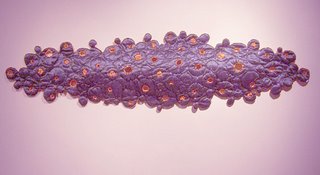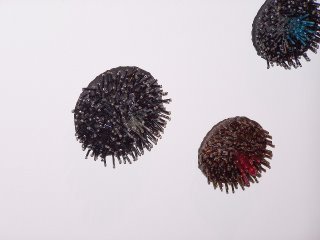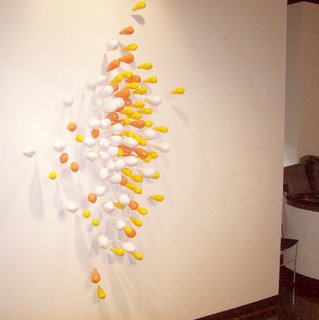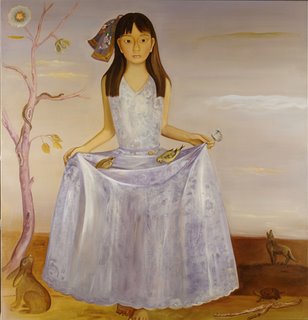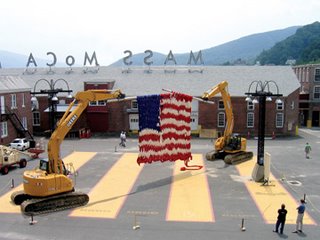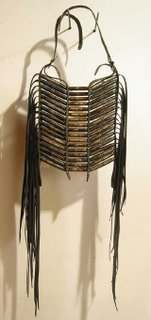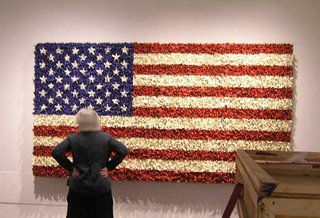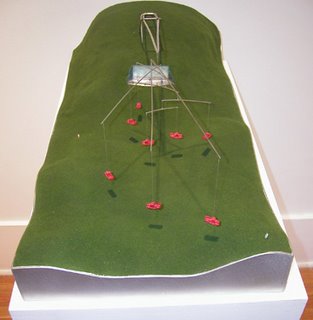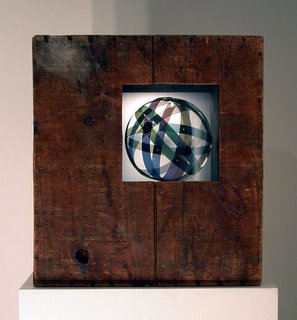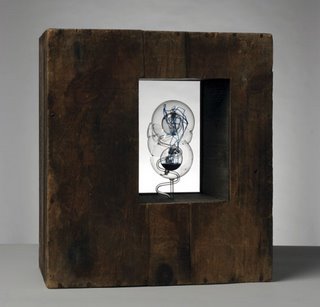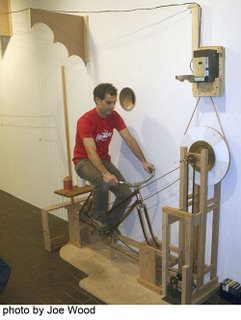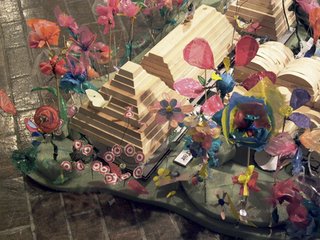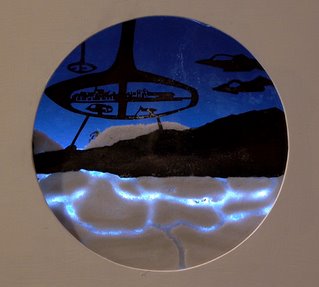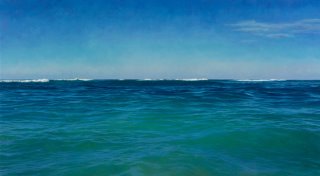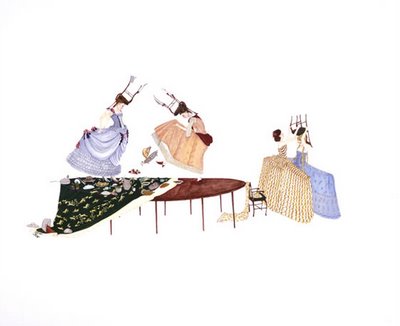Cristi Rinklin
South Boston artist Cristi Rinklin’s 16 paintings at Rhys Gallery continue her exploration of the brightly billowing, smoky forms with which she’s swathed the walls and windows at Tufts University’s Art Gallery through Jan. 14. Here her abstractions 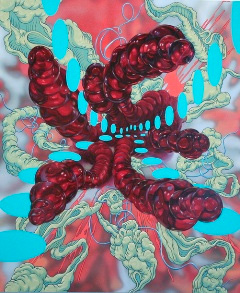 of eye-popping sky blues and candy reds, accented by greens and purples, are hybrids of the stylized clouds of classic Asian paintings; drapery and landscapes you might see tucked in the backgrounds of old master portraits; and floating webs that could be Eva Hesse doodles. Things resembling tentacles or maybe intestines made of glass doorknobs wiggle out toward you. Cartoony drapery and clouds somehow bring to mind lady parts.
of eye-popping sky blues and candy reds, accented by greens and purples, are hybrids of the stylized clouds of classic Asian paintings; drapery and landscapes you might see tucked in the backgrounds of old master portraits; and floating webs that could be Eva Hesse doodles. Things resembling tentacles or maybe intestines made of glass doorknobs wiggle out toward you. Cartoony drapery and clouds somehow bring to mind lady parts.
Rinklin floats crisp shapes -- some photographically “realistic” imaginings, some flat outlined cartoon forms -- atop backgrounds blurred to suggest deep space. All this layering, blurring and stretching of forms feels like Photoshop – and it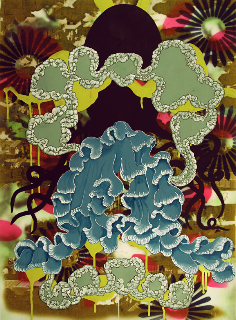 is. Rinklin digitally reworks and combines images she collects from Baroque painting, cells, constellations, natural history illustration. In an artist statement, she says she’s thinking about how the sea of images and data in our synthetic Sims world has infested our imaginations.
is. Rinklin digitally reworks and combines images she collects from Baroque painting, cells, constellations, natural history illustration. In an artist statement, she says she’s thinking about how the sea of images and data in our synthetic Sims world has infested our imaginations.
Our ever more artificially, technologically manipulated world is one of the preeminent issues of art (and life) today. You see it when Danish artist Heidi Hove Pedersen, who also has work on view at Rhys, and Cambridge artist Kelly Sherman, one of the finalists for the 2006 ICA Artist Prize with work on view at the new Institute of Contemporary Art, trawl the Net for images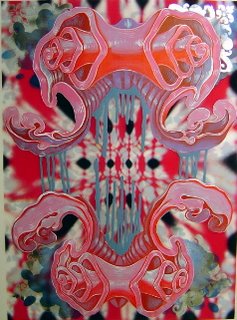 and information, trying to trace human connections. And in an exciting related development, we’re beginning to see artists not just mine the Web for material, but making Flickr, eBay and other online entities their medium.
and information, trying to trace human connections. And in an exciting related development, we’re beginning to see artists not just mine the Web for material, but making Flickr, eBay and other online entities their medium.
Rinklin is at the handmade end of this issue, and part of the delight of her work is her suave craftsmanship. Her paintings seem like jaunty, playful cousins to paintings by folks like Sarah Walker, Peter Saul, Philip Hansen and Lari Pittman. They’re tasty treats, like cotton candy, and after a while all the sugar starts to make you feel sick. Underneath all the razzmatazz is an emptiness that echoes the anxious, troubling, lonely hollowness at the heart of the Internet. This is a conceptual success, but--
Cristi Rinklin (and Heidi Hove Pedersen) at Rhys Gallery, 40 Fay St., Boston. Nov. 30, 2006, to Jan. 27, 2007.
 of eye-popping sky blues and candy reds, accented by greens and purples, are hybrids of the stylized clouds of classic Asian paintings; drapery and landscapes you might see tucked in the backgrounds of old master portraits; and floating webs that could be Eva Hesse doodles. Things resembling tentacles or maybe intestines made of glass doorknobs wiggle out toward you. Cartoony drapery and clouds somehow bring to mind lady parts.
of eye-popping sky blues and candy reds, accented by greens and purples, are hybrids of the stylized clouds of classic Asian paintings; drapery and landscapes you might see tucked in the backgrounds of old master portraits; and floating webs that could be Eva Hesse doodles. Things resembling tentacles or maybe intestines made of glass doorknobs wiggle out toward you. Cartoony drapery and clouds somehow bring to mind lady parts.Rinklin floats crisp shapes -- some photographically “realistic” imaginings, some flat outlined cartoon forms -- atop backgrounds blurred to suggest deep space. All this layering, blurring and stretching of forms feels like Photoshop – and it
 is. Rinklin digitally reworks and combines images she collects from Baroque painting, cells, constellations, natural history illustration. In an artist statement, she says she’s thinking about how the sea of images and data in our synthetic Sims world has infested our imaginations.
is. Rinklin digitally reworks and combines images she collects from Baroque painting, cells, constellations, natural history illustration. In an artist statement, she says she’s thinking about how the sea of images and data in our synthetic Sims world has infested our imaginations.Our ever more artificially, technologically manipulated world is one of the preeminent issues of art (and life) today. You see it when Danish artist Heidi Hove Pedersen, who also has work on view at Rhys, and Cambridge artist Kelly Sherman, one of the finalists for the 2006 ICA Artist Prize with work on view at the new Institute of Contemporary Art, trawl the Net for images
 and information, trying to trace human connections. And in an exciting related development, we’re beginning to see artists not just mine the Web for material, but making Flickr, eBay and other online entities their medium.
and information, trying to trace human connections. And in an exciting related development, we’re beginning to see artists not just mine the Web for material, but making Flickr, eBay and other online entities their medium.Rinklin is at the handmade end of this issue, and part of the delight of her work is her suave craftsmanship. Her paintings seem like jaunty, playful cousins to paintings by folks like Sarah Walker, Peter Saul, Philip Hansen and Lari Pittman. They’re tasty treats, like cotton candy, and after a while all the sugar starts to make you feel sick. Underneath all the razzmatazz is an emptiness that echoes the anxious, troubling, lonely hollowness at the heart of the Internet. This is a conceptual success, but--
Cristi Rinklin (and Heidi Hove Pedersen) at Rhys Gallery, 40 Fay St., Boston. Nov. 30, 2006, to Jan. 27, 2007.





